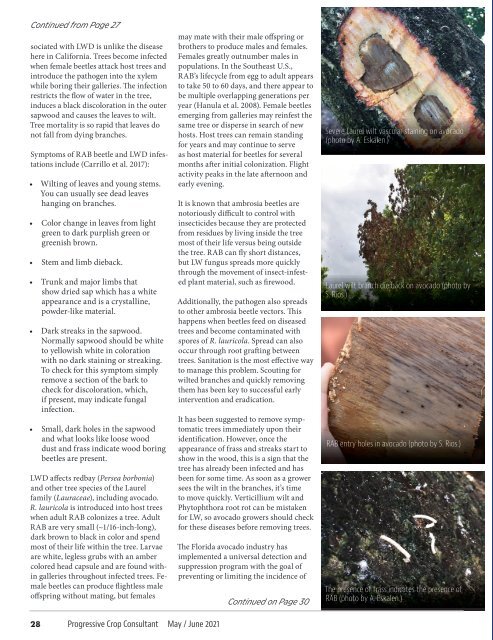Progressive Crop Consultant May/June 2021
Create successful ePaper yourself
Turn your PDF publications into a flip-book with our unique Google optimized e-Paper software.
Continued from Page 27<br />
sociated with LWD is unlike the disease<br />
here in California. Trees become infected<br />
when female beetles attack host trees and<br />
introduce the pathogen into the xylem<br />
while boring their galleries. The infection<br />
restricts the flow of water in the tree,<br />
induces a black discoloration in the outer<br />
sapwood and causes the leaves to wilt.<br />
Tree mortality is so rapid that leaves do<br />
not fall from dying branches.<br />
Symptoms of RAB beetle and LWD infestations<br />
include (Carrillo et al. 2017):<br />
• Wilting of leaves and young stems.<br />
You can usually see dead leaves<br />
hanging on branches.<br />
• Color change in leaves from light<br />
green to dark purplish green or<br />
greenish brown.<br />
• Stem and limb dieback.<br />
• Trunk and major limbs that<br />
show dried sap which has a white<br />
appearance and is a crystalline,<br />
powder-like material.<br />
• Dark streaks in the sapwood.<br />
Normally sapwood should be white<br />
to yellowish white in coloration<br />
with no dark staining or streaking.<br />
To check for this symptom simply<br />
remove a section of the bark to<br />
check for discoloration, which,<br />
if present, may indicate fungal<br />
infection.<br />
• Small, dark holes in the sapwood<br />
and what looks like loose wood<br />
dust and frass indicate wood boring<br />
beetles are present.<br />
LWD affects redbay (Persea borbonia)<br />
and other tree species of the Laurel<br />
family (Lauraceae), including avocado.<br />
R. lauricola is introduced into host trees<br />
when adult RAB colonizes a tree. Adult<br />
RAB are very small (~1/16-inch-long),<br />
dark brown to black in color and spend<br />
most of their life within the tree. Larvae<br />
are white, legless grubs with an amber<br />
colored head capsule and are found within<br />
galleries throughout infected trees. Female<br />
beetles can produce flightless male<br />
offspring without mating, but females<br />
may mate with their male offspring or<br />
brothers to produce males and females.<br />
Females greatly outnumber males in<br />
populations. In the Southeast U.S.,<br />
RAB’s lifecycle from egg to adult appears<br />
to take 50 to 60 days, and there appear to<br />
be multiple overlapping generations per<br />
year (Hanula et al. 2008). Female beetles<br />
emerging from galleries may reinfest the<br />
same tree or disperse in search of new<br />
hosts. Host trees can remain standing<br />
for years and may continue to serve<br />
as host material for beetles for several<br />
months after initial colonization. Flight<br />
activity peaks in the late afternoon and<br />
early evening.<br />
It is known that ambrosia beetles are<br />
notoriously difficult to control with<br />
insecticides because they are protected<br />
from residues by living inside the tree<br />
most of their life versus being outside<br />
the tree. RAB can fly short distances,<br />
but LW fungus spreads more quickly<br />
through the movement of insect-infested<br />
plant material, such as firewood.<br />
Additionally, the pathogen also spreads<br />
to other ambrosia beetle vectors. This<br />
happens when beetles feed on diseased<br />
trees and become contaminated with<br />
spores of R. lauricola. Spread can also<br />
occur through root grafting between<br />
trees. Sanitation is the most effective way<br />
to manage this problem. Scouting for<br />
wilted branches and quickly removing<br />
them has been key to successful early<br />
intervention and eradication.<br />
It has been suggested to remove symptomatic<br />
trees immediately upon their<br />
identification. However, once the<br />
appearance of frass and streaks start to<br />
show in the wood, this is a sign that the<br />
tree has already been infected and has<br />
been for some time. As soon as a grower<br />
sees the wilt in the branches, it’s time<br />
to move quickly. Verticillium wilt and<br />
Phytophthora root rot can be mistaken<br />
for LW, so avocado growers should check<br />
for these diseases before removing trees.<br />
The Florida avocado industry has<br />
implemented a universal detection and<br />
suppression program with the goal of<br />
preventing or limiting the incidence of<br />
Continued on Page 30<br />
Severe Laurel wilt vascular staining on avocado<br />
(photo by A. Eskalen.)<br />
Laurel wilt branch die back on avocado (photo by<br />
S. Rios.)<br />
RAB entry holes in avocado (photo by S. Rios.)<br />
The presence of frass indicates the presence of<br />
RAB (photo by A. Eskalen.)<br />
28 <strong>Progressive</strong> <strong>Crop</strong> <strong>Consultant</strong> <strong>May</strong> / <strong>June</strong> <strong>2021</strong>


















